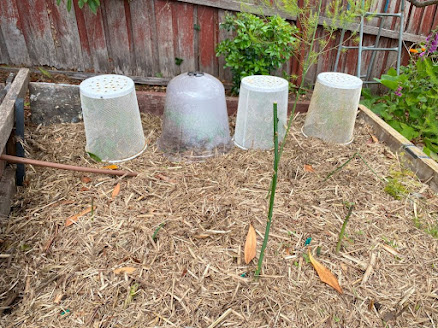A cool, calm spring morning greeted our food garden visitors to Rose Bay this month, where we discovered a gorgeous and highly productive garden tucked away in Max and Gaye’s suburban backyard. In addition to the great garden, lovely company and fabulous food, we were also treated to a crash course in all things crop protection!
Max and Gaye started the transformation of the, previously, uninteresting backyard about 21 years ago. Max explained that it was a process of evolution, through “organic” and gradual expansion of the area under cultivation, rather than the implementation of a pre-planned garden design. While Max freely admits the final result is perhaps not the most efficient garden layout, I think everyone agreed the outcome was a beautiful, free-flowing space that was a pleasure to be immersed in.
With the benefit of a sunny aspect and small hot house, the garden was packed full of edibles – from dwarf and espaliered fruit trees, grapes, berries and currants, through to potatoes, tomatoes, peas, caulies, carrots, silverbeet and cucumbers, to name just a few. There were also some less-common crops, such as the pepino in the second image below (which looks a little like a tomato, but which, when ripe, tastes like a melon).
The garden made great use of herbs and flowers intermingled with the fruit and vegetables to attract pollinators and create a beautiful environment in which to garden. Herbs such as mint, parsley, coriander and rosemary, along with columbines, delphiniums, marigolds, geraniums and gorgeous red poppies (a bumble bee favourite – see bottom left inside the bloom) combined to add colour and biodiversity to the space.
Max explained the many and varied crop protection methods used in the garden to address a range of environmental challenges, such as browsing animals (rats, possums, wallabies), birds, insects and weather extremes. These included:
- weather protection in the form of a glass house and screens made from tree bags
- netted garden beds of various sizes
Reinforced netting: available from Haverford here.
Metal frame connectors: Build A Frame PE196 available from Green Harvest here.
- individual plant protection in the form of cloches, aviary wire row guards and inverted waste paper bins.
Following a question from the floor, Max also gave a run down on the range of irrigations systems used throughout the garden – including weeping hoses, inline dripper hoses and individual pot drippers – and the advantages and disadvantages of each. He also communicated the convenience of having invested in a quality watering control system.
For those who would like to know more, these irrigation options are all discussed in Food Garden Group blog post Improving your Irrigation here.
Max and Gaye talked about the importance of maintaining the long-term health and productivity of the soil through regular applications of organic fertiliser and compost, the use of green manures and crop rotation. Max uses a two-bin open system to generate their compost requirements.
Find out more about complete organic fertiliser in our Food Garden Group discussion here.
Gaye pointed out this silverbeet “tree” as an example of allowing some plants to go to seed – giving a never-ending supply of free plants.
Max and Gaye’s garden clearly demonstrates that you don’t need a large space to have a productive and aesthetically pleasing patch, and that with a little persistence and innovation you can also overcome some of those pesky pest problems that arise from time to time.
It was great to see some new faces at this month’s garden visit, and as you can see from the produce and morning tea tables, we were all well fed and returned home with some goodies :-)
Thanks everyone for your contributions!


























No comments:
Post a Comment
Note: Only a member of this blog may post a comment.